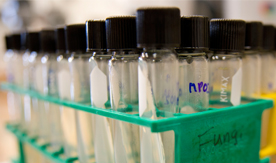
UMaine Lab Maintains one of World’s Most Comprehensive Collections of Frog Fungus Cultures
In the November issue of the journal Molecular Ecology, a U.S. and Brazilian research team reported evidence of novel and hybrid strains of a lethal fungus that has decimated amphibian populations worldwide. The paper, which was featured in the journal’s News and Views article, reported on the genetic diversity of the fungus on introduced, native and cultivated North American bullfrogs that supply the global market for frog legs.
The genetic work was possible with the help of one of the most comprehensive collections of frog fungus cultures in the world — the Maine Chytrid Laboratory, led by mycologist Joyce Longcore, a research associate professor in the University of Maine’s School of Biology and Ecology.
For more than a quarter century, Longcore has isolated and cultivated aquatic fungi known as chytrids. Her cultures are a resource for studying the relationships of these microscopic fungi and have been used in recent descriptions of several new taxonomic orders. Her cultures of the fungus that causes chytridiomycosis in amphibians, scientifically known as Batrachochytrium dendrobatidis (Bd) reflect samples from all over the world and are used in labs in the United States, Central America and Europe to study pathogenicity, host resistance and distribution of the fungus.
In this specialized field of amphibian disease research, the Maine Chytrid Laboratory is to frog fungi what The Jackson Laboratory is to mouse strains.
Longcore was the first to isolate a pure culture of the chytrid in 1997 in response to a die-off of exotic frogs in captivity at the Smithsonian National Zoological Park in Washington, D.C. Simultaneously, scientists found the organism decimating frog populations in Australia and Central America.
Not only are Longcore’s cultures key to understanding origins and implications of Bd, but her methods for culturing the problematic pathogen bring international researchers to her door. Schloegel, the lead author of the Molecular Ecology paper, and co-author Luis Toledo of UNICAMP in Brazil both learned to isolate Bd in the Longcore lab. In collaboration with another of the co-authors, Timothy James of the University of Michigan, Longcore’s cultures have been instrumental in earlier papers on Bd genetics, as well as studies examining the relationships among other chytrid fungi.
Researchers continue to seek answers about the origins of Bd and why it kills certain amphibian species and not others. Just as important, scientists continue to fathom what the loss — and, in some cases, the extinction — of amphibian species means to the environment.
The spread of the fungus that causes chytridiomycosis is symptomatic of the homogenizing of environments, according to Longcore. Through global trade of wildlife, invisible pathogens are introduced that can have far reaching consequences, such as the Bd-associated, drastic declines in amphibian populations on at least four continents.
In all of these regions, including Maine, where amphibian declines have not been reported, amphibians are infected with the same global pathogenic genetic lineage of the fungus. With the finding from Brazil of a novel strain and a hybrid strain that is intermediate between the novel strain and the global pathogenic strains, scientists know that genetic diversity of the fungus is more complex than first realized and, importantly, that different strains can recombine, Longcore says.
“Humans have helped spread this strain by the international trade in amphibians,” says Longcore. “The take-home message of this particular fungus, and this particular paper, is that if we keep exposing different strains of the fungus to each other, we have the potential of another recombination event, and we don’t know how virulent that next strain will be.”
Contact: Joyce Longcore, 207.581.4396
